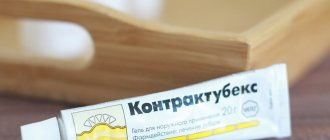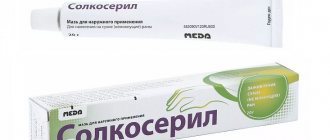Pharmacological properties of the drug Nise gel
Nise gel contains nimesulide, a selective COX-2 inhibitor. It has an analgesic and anti-inflammatory effect due to the inhibition of COX-2, which leads to inhibition of the synthesis of prostaglandins, which are involved in the formation of edema and pain during inflammation. Nimesulide inhibits platelet activation factor, tumor necrosis factor alpha, and the release of proteinases and histamine. Methyl salicylate, a derivative of salicylic acid, has a local irritating and distracting effect. Menthol has an analgesic effect, accompanied by a feeling of cold. The analgesic effect of menthol is associated with stimulation of cold receptors, stabilization of calcium ion flows through the channels of neuronal membranes. Capsaicin has a local irritant effect, causes a local increase in blood flow and tissue hyperemia at the site of application, and promotes the release of endogenous biologically active substances. Nise gel is characterized by high safety of use (virtually no side effects are noted). When applied externally, the gel is gradually absorbed through the skin into the underlying muscle or synovial fluid. Equilibrium concentrations between skin and muscle or synovial fluid are achieved quickly. With local application of Nise gel, systemic absorption is insignificant, since the levels of nimesulide in the blood plasma remained below the detection limit of high-performance liquid chromatography and only after 5 hours very low concentrations (100 μg/l) of hydroxynimesulide in the blood plasma were detected.
Pharmacological group
Nise gel belongs to the group of non-steroidal anti-inflammatory drugs that block the release of substances that provoke pain. In the matter of joint pain, it is necessary to control the synthesis of prostaglandin H2. and E2. At the site of inflammation, these substances are produced with great intensity, and impulses from them enter the spinal cord.
Nise gel is able to block the synthesis of these substances. This action has an analgesic effect. In addition, the use of the gel relieves the severity of inflammation.
If the work of the joints is difficult after sleep, Nise gel is used before the development of the inflammatory process. This allows you to start your day pain-free.
When used topically, nimesulide is not absorbed into the blood or is absorbed in extremely low doses. The maximum possible concentration of the substance is achieved only at the end of the first day of use of the product, and its volume is almost 300 times less than after a single oral dose of nimesulide. No derivative metabolites of the substance are detected in the blood.
Special instructions for the use of the drug Nise gel
The drug is intended for external use. Elderly patients with significant impairment of liver and kidney function, patients with congestive heart failure should use the drug with caution. It is recommended to apply the gel only to intact areas of the skin, avoid contact with open wounds. Do not use the gel under airtight or tight bandages. Avoid getting the gel into the eyes and mucous membranes. Wash your hands thoroughly before and after using the gel. Indications for use of the gel in children and dosage have not been established.
Indications for use of Nise gel
Nise gel is prescribed for diseases of the musculoskeletal system. Among them:
- rheumatoid arthritis;
- joint damage by osteoarthritis;
- radiculitis;
- inflammation of ligaments and articular discs, as well as bursitis;
- muscle pain caused by rheumatism;
- exacerbation of gout.
In addition to diseases, Nise gel is recommended for use after injuries:
- bruises;
- sprains;
- dislocations;
- ligament ruptures.
When the joints are affected due to the progression of psoriasis, you can relieve inflammation by rubbing in Nise gel. However, if there is an ulcer or psoriatic plaque on the surface of the skin above the joint, applying the gel is undesirable, especially when any trauma to the surface of the scaly wound leads to bleeding and increased inflammation.
Instructions for use NISE GEL
1. Nimesulide is a non-steroidal anti-inflammatory drug (NSAID) from the sulfonanilide class, has analgesic, anti-inflammatory and antipyretic effects.
The effect is due to the selective blockade of cyclooxygenase-2, as well as a number of other mechanisms, such as:
- suppression of platelet activating factor synthesis;
- reduction of superoxide anion production by stimulated polymorphonuclear leukocytes through suppression of protein kinase C and type IV phosphodiesterase;
- preventing bradykinin and cytokine-induced hyperalgesia by inhibiting the release of tumor necrosis factor α;
- neutralization of hypochloric acid;
- prevention of inactivation of α-proteinase inhibitors;
- inhibition of proteases (including elastase, collagenase);
- inhibition of histamine release from basophils and mast cells;
- slowing down the degradation of the cartilage matrix by inhibiting the synthesis of metalloproteases.
2. Menthol has a local irritant, analgesic, distracting, antipruritic, antiseptic, and sedative effect. The effect is mainly due to reflex reactions associated with irritation of sensory nerve endings:
- irritation of skin or mucous membrane receptors stimulates the formation and release of endogenous biologically active substances (enkephalins, endorphins, peptides, kinins) involved in the regulation of pain, vascular permeability and other processes, providing analgesic, distracting and antipruritic effects. Antiseptic activity is manifested by indiscriminate damage to microbial cells. The irritating (distracting) effect helps reduce pain. The local effect is accompanied by vasoconstriction, a feeling of cold, turning into a feeling of slight burning and tingling. Skin-visceral reflexes (the reflex arc does not affect the brain) improve tissue trophism (according to the innervation zones). Reflexively changes the tone of blood vessels, both superficial and deep in tissues and internal organs.
3. Capsaicin has an effect by reducing the content of substance P, which is a neurotransmitter that carries out pain and itching reactions from the receptors of the peripheral nervous system to the central one. Capsaicin blocks the synthesis and transmission of substance P along the neuron, which leads to a decrease in the intensity of the pain impulse.
4. Methyl salicylate is a derivative of salicylic acid. When applied locally, it quickly penetrates into the deep layers of the skin, is absorbed, hydrolyzed and converted into salicylic acid anion. Non-selectively inhibits cyclooxygenase, reduces the synthesis of prostaglandins responsible for inflammation, pain, and fever. Normalizes increased capillary permeability, improves microcirculation processes, reduces swelling and infiltration of inflamed tissues, causes a decrease in pain in pathologies of joints, muscles and soft tissues. It has a local irritant effect on the skin, which helps reduce pain.
In various studies, nimesulide turned out to be a non-mutagenic drug. There is also no data on the effect of the drug on the chromosomes of lymphocytes in vitro, and the interaction with H-thymidine of cultured human lymphocytes.
Nise gel (1% 50g)
INSTRUCTIONS for use of the medicinal product for medical use NIZE®
Registration number: P N012824/02
Trade name: Nise®
International nonproprietary name: nimesulide
Chemical name: N-(4-nitro-2-phenoxyphenyl) methanesulfonanilide
Dosage form: gel for external use
Composition: 1 g of gel contains: active substance: nimesulide 10 mg; excipients: N-methyl-2-pyrrolidone 250 mg, propylene glycol 100 mg, macrogol 315.5 mg, isopropanol 100 mg, purified water 200 mg, carbomer-940 20 mg, butylated hydroxyanisole 0.2 mg, thiomersal 0.1 mg, potassium dihydrogen phosphate 0.2 mg, flavor (Narcissus-938) 4 mg.
Description: transparent gel of light yellow or yellow color, free from foreign particles.
Pharmacotherapeutic group: non-steroidal anti-inflammatory drug (NSAID)
ATX code: M01AX17
Pharmacological action Nise® gel is a new generation non-steroidal anti-inflammatory drug (NSAID) from the sulfonamide class. It has a local analgesic and anti-inflammatory effect. Nimesulide is a selective competitive reversible inhibitor of cyclooxygenase type II (endoperoxide-prostaglandin-H2 synthetase). Reduces the concentration of short-lived prostaglandin H2, a substrate for kinin-stimulated synthesis of prostaglandin E2, at the site of inflammation and in the ascending pathways of pain impulses in the spinal cord. A decrease in the concentration of prostaglandin E2 (a mediator of inflammation and pain) reduces the activation of EP type prostanoid receptors, which is manifested by analgesic and anti-inflammatory effects. When applied topically, it causes a weakening or disappearance of pain at the site of application of the gel, including pain in the joints at rest and during movement, reduces morning stiffness and swelling of the joints. Helps increase range of motion.
Pharmacokinetics When applying the gel, the concentration of the active substance in the systemic circulation is extremely low. The maximum concentration after a single application is observed at the end of the first day; its value is more than 300 times lower than that for oral dosage forms of nimesulide. No traces of the main metabolite of nimesulide, 4-hydroxynimesulide, are found in the blood.
Indications Local symptomatic treatment of inflammatory and degenerative diseases of the musculoskeletal system (articular syndrome with exacerbation of gout, rheumatoid arthritis, psoriatic arthritis, ankylosing spondylitis, osteoarthritis, osteochondrosis with radicular syndrome, radiculitis, inflammatory damage to ligaments, tendons, bursitis, sciatica, lumbago). Muscle pain of rheumatic and non-rheumatic origin. Post-traumatic inflammation of soft tissues and the musculoskeletal system (damage and rupture of ligaments, bruises).
Contraindications Hypersensitivity to nimesulide and the components of the drug; erosive and ulcerative lesions of the gastrointestinal tract in the acute stage, bleeding from the gastrointestinal tract, dermatoses, damage to the epidermis and skin infections in the area of application; severe renal (creatinine clearance less than 30 ml/min.) or liver failure, a history of bronchospasm associated with the use of acetylsalicylic acid or other NSAIDs, pregnancy and lactation, children under 7 years of age.
With caution : Liver failure; renal failure; severe heart failure; arterial hypertension; diabetes mellitus type 2; elderly and children's age.
Directions for use and dosage : Externally. Before applying the gel, wash and dry the skin surface. Apply a uniform thin layer of gel approximately 3 cm long to the area of maximum pain, without rubbing, 3-4 times a day. The amount of gel and the frequency of its use (no more than 4 times a day) may vary depending on the size of the treated area and the patient’s response. Do not use the gel for more than 10 days without consulting a doctor.
Side effects Local reactions: itching, urticaria, peeling, transient change in skin color (not requiring discontinuation of the drug). If any adverse reactions occur, you should stop using the drug and consult your doctor. When applying the gel to large areas of the skin or with prolonged use, the development of systemic adverse reactions is possible: heartburn, nausea, vomiting, diarrhea, gastralgia, ulceration of the gastrointestinal mucosa, increased activity of “liver” transaminases; headache, dizziness; fluid retention, hematuria; allergic reactions (anaphylactic shock, skin rash); thrombocytopenia, leukopenia, anemia, agranulocytosis, prolongation of bleeding time.
Overdose Cases of drug overdose have not been described. However, when large quantities of gel (exceeding 50 g) are applied to large areas of skin, the development of an overdose cannot be ruled out. There is no specific antidote. You need to see a doctor.
Interaction with other drugs Pharmacokinetic interaction with drugs that compete for association with blood plasma proteins is not excluded. Caution should be exercised when using Nise® simultaneously with digoxin, phenytoin, lithium preparations, diuretics, cyclosporine, methotrexate, other NSAIDs, antihypertensive and antidiabetic agents. Before using the gel, you should consult your doctor if you are using these products or are under medical supervision.
Special instructions The drug is recommended to be applied only to intact areas of the skin, avoiding contact with open wounds. Avoid getting the gel into the eyes and other mucous membranes. Do not use the gel under airtight dressings. After applying the gel, wash your hands with soap. Close the tube tightly after using the gel.
Release form Gel for external use 1%. 20 g or 50 g in a laminated aluminum tube equipped with a membrane to control the first opening. The tube is packed in a cardboard box with instructions for use.
Shelf life: 2 years. Do not use the drug after the expiration date indicated on the package.
Storage conditions List B. In a dry place, protected from light, at a temperature not exceeding 25 °C. Do not freeze. Keep out of the reach of children!
Conditions for dispensing from pharmacies Without a prescription.
Manufacturer Dr. Reddy's Laboratories Ltd., Hyderabad, Andhra Pradesh, India
Manufacturing address Dr. Reddy's Laboratories Ltd. Plot No. 41, Nasigere Village, Kasaba Hobli, KIADB, Malur-563130, Karnataka, India.
Send consumer complaints to the following address: Representative office: 115035, Moscow, Ovchinnikovskaya embankment, 20, building 1 tel., 783-29-01 fax
Nise Gel, 20 g, 1%, for external use
Pharmacological properties
1. Nimesulide is a non-steroidal anti-inflammatory drug (NSAID) from the sulfonanilide class, has analgesic, anti-inflammatory and antipyretic effects. The effect is due to selective blockade of cyclooxygenase-2, as well as a number of other mechanisms, such as: suppression of the synthesis of platelet activating factor, reduction in the production of superoxide anion by stimulated polymorphonuclear leukocytes through suppression of protein kinase C and type IV phosphodiesterase. Prevention of bradykinin and cytokine-induced hyperalgesia by inhibiting the release of tumor necrosis factor a. , Neutralization of hypochloric acid, Prevention of inactivation of a-proteinase inhibitors, Inhibition of proteases (including elastase, collagenase), Inhibition of histamine release from basophils and mast cells, Slowing down the degradation of the cartilage matrix by inhibiting the synthesis of metalloproteases. 2. Menthol has a local irritant, analgesic, distracting, antipruritic, antiseptic, and sedative effect. The effect is mainly due to reflex reactions associated with irritation of sensitive nerve endings: irritation of skin or mucous membrane receptors stimulates the formation and release of endogenous biologically active substances (enkephalins, endorphins, peptides, kinins) involved in the regulation of pain, vascular permeability and other processes , providing analgesic, distracting and antipruritic effects. Antiseptic activity is manifested by indiscriminate damage to microbial cells. The irritating (distracting) effect helps reduce pain. The local effect is accompanied by vasoconstriction, a feeling of cold, turning into a feeling of slight burning and tingling. Skin-visceral reflexes (the reflex arc does not affect the brain) improve tissue trophism (according to the innervation zones). Reflexively changes the tone of blood vessels, both superficial and deep in tissues and internal organs. 3. Capsaicin has an effect by reducing the content of substance P, which is a neurotransmitter that carries out pain and itching reactions from the receptors of the peripheral nervous system to the central one. Capsaicin blocks the synthesis and transmission of substance P along the neuron, which leads to a decrease in the intensity of the pain impulse. 4. Methyl salicylate is a derivative of salicylic acid. When applied locally, it quickly penetrates into the deep layers of the skin, is absorbed, hydrolyzed and converted into salicylic acid anion. Non-selectively inhibits cyclooxygenase, reduces the synthesis of prostaglandins responsible for inflammation, pain, and fever. Normalizes increased capillary permeability, improves microcirculation processes, reduces swelling and infiltration of inflamed tissues, causes a decrease in pain in pathologies of joints, muscles and soft tissues. It has a local irritant effect on the skin, which helps reduce pain.


